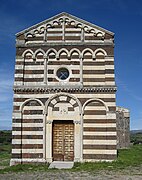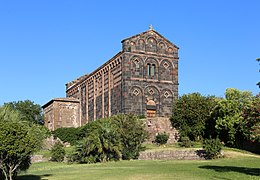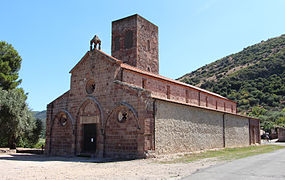Romanesque architecture in Sardinia

The Sardinian Romanesque is the
History

The first Romanesque building on the island is the
Architecture

Giulio Carlo Argan identifies in the Sardinian Romanesque of the 11th and 12th centuries a "particular attitude" to the two new Lombard and Tuscan currents,[2] which are often merged producing unprecedented results. As in the case of San Nicola di Trullas (before 1113) in Semestene (SS), the palatine chapel of Santa Maria del Regno (1107) in Ardara or the San Nicola di Silanis (before 1122) of Sedini (SS) and the Basilica of San Simplicio in Olbia (11th-12th century) just to name a few. There is no shortage of examples of exclusively Lombard architecture, as in the case of the Church of San Pietro di Zuri by master Anselmo da Como.

There are also numerous French-derived architectures built on behalf of the
Among the Romanesque architecture of Sardinia numerous examples of churches of narrow
Remarkable are also the defensive structures such as the
Image gallery
-
Saccargia, lateral view
-
Church of San Pietro delle Immagini or del Crocifisso, Bulzi
-
Cathedral of Santa Maria di Monserrato, Tratalias
-
Church of San Michele di Salvènero, Ploaghe
-
Cathedral of Sant'Antioco di Bisarcio, Ozieri
-
San Nicola, Ottana
-
Cathedral ofSan Pantaleo, Dolianova
-
Cathedral of Santa Giusta, Santa Giusta
-
Nostra signora of Tergu
-
Church of San Pietro di Zuri, Ghilarza
-
Church of San Pietro Extramuros, Bosa
References
Bibliography
- Rassu, Massimo (2008). Templari e ospitalieri in Sardegna. Dolianova. ISBN 9788889978603
- Pittui, Frank (2005). Note sulle genealogie e la poetica della chiesa di San Nicola di Silanos. Sedini. in Sacer, n. 12. Sassari.
{{cite book}}: CS1 maint: location missing publisher (link) (presente on line sul sito Indipendentzia.net. - VV., AA. (1997). Speciale Anglona Medievale in Sardegna Antica.
- Coroneo, Roberto (1993). Architettura romanica dalla metà del Mille al primo ‘300. Nuoro: Ilisso. ISBN 88-85098-24-X.
- Serra, Renata (1988). Sardegna Romanica. Milano: Jaca Book. ISBN 88-16-60096-9.
- Sari, Aldo (1981). Nuove testimonianze architettoniche per la conoscenza del Medioevo in Sardegna in Archivio Storico Sardo vol. XXXII.
- VV., AA. (1988). I Cistercensi in Sardegna. in Rivista Cistercense.
{{cite book}}: CS1 maint: location missing publisher (link) - Argan, Giulio Carlo (1978). L’architettura protocristiana, preromanica e romanica. Bari.
{{cite book}}: CS1 maint: location missing publisher (link) - Zanetti, Ginevra (1976). I Cistercensi in Sardegna - Le abbazie di S. Maria di Corte, di Paulis e di Coros. in « Archivio Storico Sardo di Sassari».
{{cite book}}: CS1 maint: location missing publisher (link) - Boscolo, Alberto (1958). L'abbazia di San Vittore, Pisa e la Sardegna. Padova.
{{cite book}}: CS1 maint: location missing publisher (link) - Delogu, Raffaello (1953). L 'Architettura del Medioevo in Sardegna. Roma.
{{cite book}}: CS1 maint: location missing publisher (link) (ristampa anastatica, Sassari, 1988) - Scano, Dionigi (1929). Chiese Medioevali di Sardegna. Firenze.
{{cite book}}: CS1 maint: location missing publisher (link) (ristampa anastatica, Cagliari, 1991) - Salvatore Chessa, L'insediamento umano medioevale nella curatoria di Montes (Comuni di Osilo e Tergu), Sassari, Magnum, 2002, scheda "Bualis-Bainzolu", pp. 145–51 (per la collocazione della chiesa cassinese di Santa Maria in Bubalis o Bualis nell'attuale territorio di Tergu).












